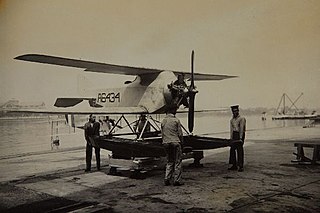
The Glasair I, originally built as the prototype Glasair TD taildragger, is a high-performance homebuilt aircraft built of fiberglass. Created by Tom Hamilton as a fast, two-seat kitplane, the Glasair TD was derived from the earlier Tom Hamilton Glasair and first flew in 1979. Hamilton formed Stoddard-Hamilton Aircraft that year to produce and market the kit, which was the first pre-molded composite aircraft available to builders.
The Heinkel HE 1 was a two-seat, low-wing monoplane floatplane, designed in 1921 by German designer Ernst Heinkel at Caspar-Werke.

The Focke-Wulf A 20 Habicht was an airliner developed in Germany in the late 1920s. It was a high-wing cantilever monoplane with fixed tailskid undercarriage. The fuselage was deep and seated four passengers in a fully enclosed cabin. The type was not bought by the airlines and only a few examples were built.

The Caspar U.1 was a 1920s German patrol seaplane designed by Ernst Heinkel and built by Caspar-Werke. The U.1 was designed to fit into a cylindrical container to allow it to be carried, then launched from a submarine.

The Horten H.III was a flying wing sailplane built by Walter and Reimar Horten in Germany from 1937 to 1944.
The Nihon L7P was a Japanese military seaplane built in World War II in the early 1940s.
The Caspar C 30, aka Caspar LE 30 was an aerial reconnaissance aircraft developed in Germany and built in Denmark in the late 1920s.
The Nicolas-Claude NC-2 Aquilon was a single-seat touring aircraft built in the late 1930s, featuring a low-wing monoplane with canard foreplanes. The NC-2 was first flown on 5 April 1937 at Auxerre.
The Caspar C 23 was a sports aircraft developed in Germany in the mid-1920s.
The Caspar C 24 was a sports aircraft developed in Germany in the mid-1920s.
The Caspar C 26 was a sports aircraft developed in Germany in the mid-1920s.
The Caspar C 27 was a training seaplane aircraft developed in Germany in the late 1920s.
The Caspar C 23 was a sports aircraft developed in Germany in the mid-1920s.
The Caspar C 33 was a training aircraft developed in Germany in the late 1920s.
The Caspar CT 1 was a sports aircraft developed in Germany in the early 1920s.
The Caspar CJ 14 was a German fighter aircraft built in the 1920s.
The Caspar CS 14 was a German fighter aircraft built in the 1920s.
The Caspar CLE 11 was an airliner built in Germany in the early 1920s.
The Caspar CLE 16 was an airliner built in Germany in the early 1920s.
The Caspar CLE 12 was an airliner built in Germany in the early 1920s.




